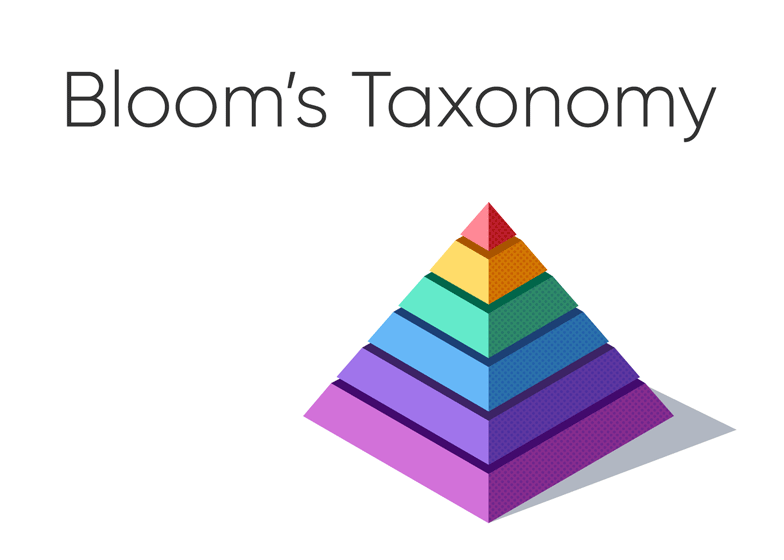Bloom's Taxonomy
Bloom's taxonomy helps educators develop critical thinking skills and higher order cognitive abilities in their students and whether you are a teacher or a student you can use the principles to master whatever you are learning or teaching.
I've talked about cognitive learning and the difference between memorizing a fact and understanding a concept effectively and efficiently. But how do you actually master something, how do you know when you are a master and where do things like active recall fit in?
Bloom's taxonomy is a high level teaching and studying strategy that I've touched on before and it's incredibly useful when it comes to learning anything or when revising for exams.
It allows teachers and students to classify and organize learning objectives and it's based on cognitive learning and assumes that learning should be structured from easy to difficult in six logical steps.
-4.png)
What Is Bloom’s Taxonomy?
Bloom's Taxonomy was first created in 1946 by American psychologist Benjamin Bloom and was later revised by Lauren Anderson to the version we know today. It serves as the backbone of many teaching philosophies in particular those geared towards teaching specific skills. A taxonomy is a way of classifying things and Bloom's Taxonomy classifies thinking and learning into six cognitive levels of complexity. Each level usually comes with a clear learning objective that can be tested and learners and teachers can use the taxonomy to set learning objectives, align outcomes to master a concept and having levels of learning classified helps us to understand whether we have actually attained the next level in a particular skill.
So the taxonomy describes six different levels of cognitive learning in the form of a hierarchy. At its most basic level, the taxonomy describes the essential abilities needed to recall information that has been taught. While at the highest level it describes a learner’s ability to take what has been taught, analyze it and use it to create and evaluate, effectively having mastered a skill or topic.

While this all sounds helpful critics of the taxonomy often question the existence of a sequential hierarchical link between each level and argue that the levels might be better placed alongside each other but before we get into some deeper learning psychology arguments and where things like active recall fit into Bloom's Taxonomy let's look at each of the levels in turn.
Remembering
Remembering is knowing the facts, being able to recall information and the ability to describe what has been learned. It's recognizing and recalling and it's focused on factual knowledge. Remembering is really just rote memorization and recollection of facts without much understanding. For example if you're learning a language you might memorize a new word without knowing it's tenses or how to pronounce it or if you are learning a skill or new concept you might learn a term but not know what it means or how to apply it. Once the basic facts are learned we can move on to understanding.
Understanding
Understanding is then the ability to interpret the information that has been learned in order to present, summarize or paraphrase it. We begin to decode the factual information and for example when learning a language we might understand deeper concepts around how words change based on a tense or pronoun or if we are learning something like anatomy in medical school we can not only remember what the heart is but we also understand that it is a pump that supports life by pumping blood around the body. In terms of knowledge we begin to understand principles and classifications like language grammar and tenses. Once we understand something we can then apply the concepts that we have learned.
Applying
Applying is taking what has been learned and using it to solve a related problem or complete a task. Application is about implementing our knowledge and executing based on our ability to recall and understand something. Applying language skills might be writing a sentence or speaking in the language we are learning or if we are studying for an exam this might be completing a simple test question based on the concepts learned.
Analyzing
Analyzing is a deeper level of understanding; organizing, comparing, and deconstructing the relationship between different aspects of the material. This involves examining and breaking down information into components determining how the parts relate to one another and finding evidence to support generalisations. If you are studying medicine this might be identifying and comparing patient physiological signs to diagnose that someone is in heart failure or if you are learning a language this might be analysing a more complex sentence and organising a response without prompts.
Evaluating
Evaluating is the ability to judge the information and critique it to choose a specific course of action. In our medical example after analysing test results or a patient's observations you might evaluate the best treatment options for that patient or for language learners this might be choosing the correct response to a more complex sentence.
-4.png)
Creating
Finally creating is generating new ideas or ways of looking at things and inventing, constructing, producing, or designing new things. In simple terms for any learner this might simply be creating your own teaching materials or questions from your existing knowledge. For medical professionals this might be undertaking research into heart failure to define new treatment options that have yet to be discovered and in languages this might be developing your own short-hand phrases or ability to fluently and automatically respond in the language you have learned.
Now that we understand each of the six levels let's look at how they can help you when learning.
How Can You Use Bloom's Taxonomy?
So if you're like most students you will be memorizing material for your exams but by just memorizing there's no real thinking behind it so you're not really processing the information therefore you're only storing it in your short-term memory and if you are asked an exam question where you need to actually apply your knowledge you are going to struggle. I've covered this in my previous videos on learning new content and moving up Bloom's hierarchy is really about ensuring that you are using evidence-based learning techniques like active recall to not just memorise facts but to also test yourself on your understanding of what you are learning by for example summarising back a concept in your own words and then applying that knowledge by actively doing practise questions of increasing difficulty which test your ability to analyse information and evaluate it.
When learning anything you can ask yourself "what level am I at?" and can I do a practise exam question or reply to a question in a language I'm learning by applying my knowledge and can I do higher level things like evaluating information and taking a specific course of action. All of this allows you to learn at an appropriate difficulty and set learning objectives that increase your knowledge and ability in a skill or whatever you are learning.
When learning or teaching you should consider the depth of cognitive learning you need to achieve from a given subject or course.
- For example, if you’re learning basic steps in a new skill or entry level topics for an exam, it’s likely that remembering, understanding and applying the information provided is sufficient to pass an exam which focuses on recalling facts.
- If you’re training to be a doctor or nurse and need to learn about leadership and making critical team-based decisions, the level of cognitive learning needed must be deeper – important clinical decisions will require analysis, evaluative and creative skills that come later in the taxonomy.
To get to the top of the pyramid, and effectively master a topic, teaching others and effectively creating your own teaching material is one of the best ways to learn as it forces you to go through the taxonomy, form your own opinions and then teach others.
By understanding your own level of ability against the taxonomy or if you're a teacher understanding your students ability you can better set yourself learning goals and use active recall questions that are of an appropriate difficulty so as to move you to the next level. For example rather than just using active recall to test yourself on medical facts like what the valves of the heart are called you might want to test yourself on the signs and symptoms of when these valves fail and why this happens in order to better understand heart failure and valve disease.
-4.png)


